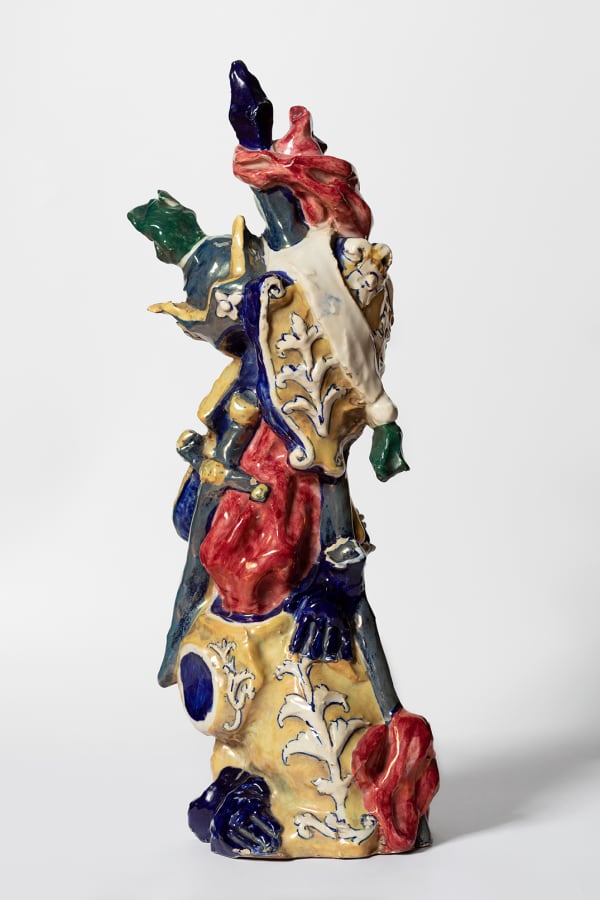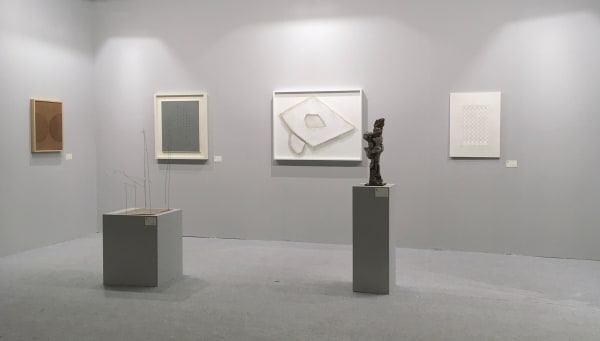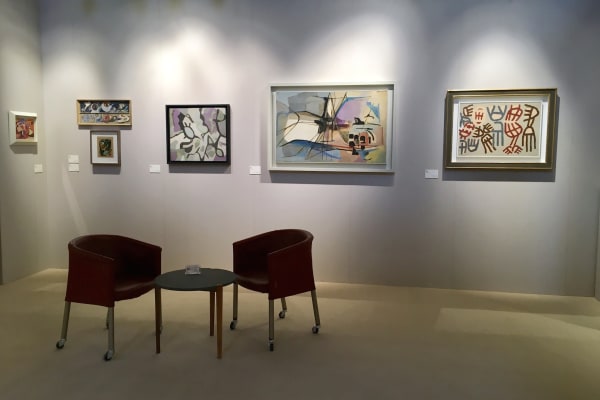Leoncillo Leonardi Italian, 1915-1968
Leoncillo Leonardi was born in Spoleto in 1915.
In 1935 Leoncillo moved to Rome where he attended the Academy of Fine Arts. He met De Libero and Cagli, inspirers of the La Cometa gallery, meeting place for younger artists Mario Mafai and Antonietta Raphael, Corrado Cagli, Mirko and Afro Basaldella, Pericle Fazzini, and Marino Mazzacurati.
In 1939 he moved to Umbertide (Umbria) where he worked with ceramics, a technique that will remain a constant in his production. Among the major works of the early Roman period are the mythological monsters: The Harpy, The Siren, The Hermaphrodite, The St. Sebastian (Rome, National Gallery of Modern Art); and again The Suoners and The Four Seasons. These are polychrome glazed earthenware, molded from the inside to obtain swollen volumes, with a soft appearance, where the glazes give sudden flashes that light up the color of skilful tonality. In 1940, at the invitation of Giò Ponti, he participated in the VII Triennale di Milano. At the end of 1941, after having avoided the attendance of the course for official students at the time of the call to arms, he published in Milan a collection of short poems, The Bestiary. He took part in the Resistance and after the Liberation he exhibited with Cagli, Guttuso, Mafai, Mirko and others in the roman exhibition Art against barbarism, in 1944, winning the first prize with two versions of the Roman mother killed by the fascists. In 1947 he joined the New Front of the Arts with Corpora, Franchina, Fazzini and Turcato, with whom he exhibited at the Venice Biennale in 1948. In 1949 he made his first solo exhibition at the Galleria del Fiore in Florence, presented by Roberto Longhi. In 1956, following a profound ideological crisis, he resigned from the Communist Party and began a severe revision of his work over the last decade. In 1957 he exhibited at Plinio De Martiis' La Tartaruga, a new production decidedly oriented in an informal sense. His bright colors and the control of plastics and enamels, lad him to results of the highest level, in which he also deals with spatial themes not far fromLucio Fontana's.
-

RITORNO AL BAROCCO
FONTANA LEONCILLO MELOTTI 2 Feb - 30 Apr 2021MILAN - ML Fine Art is pleased to announce the upcoming exhibition RITORNO AL BAROCCO: FONTANA, LEONCILLO, MELOTTI, curated by Andrea Bacchi. The title of the exhibition recalls a famous...Read more -

Close Quarters
19 Jun - 25 Sep 2020LONDON - ML Fine Art presents a group exhibition of Italian and international twentieth-century art. Complemented by a selection of modern design from Madrid, London and New York based gallery Portuondo, Close Quarters alludes to the household of an imagined collector.Read more
The sensual encounter with this eclectic collection delineates an imperfect portrait, which the viewer is invited to complete. Simultaneously intimate and startingly impersonal, the objects on view invite speculative incursions on the life of our unnamed protagonist: what did he buy, and what did he inherit? What has he already sold?
Leoncillo was born on the 18th of November 1915 in Spoleto, an Etruscan, Roman and Medieval town in the heart of Umbria, a region famous for its ancient traditional ceramic workshops. His father, who died when the child was three, taught drawing in the local technical school “G. Spagna”, where Leoncillo signed up in 1926. Confined at home during a summer for punishment, he discovers clay at the age of 14: his first preserved work, a funny monkey.
Encouraged by the Calabrian sculptor Domenico Diano, author of Spoleto’s WW1 memorial, he attends the Art School in Perugia from 1931 to 1935, his first works are portraits in Medardo Rosso’s style. He soon moves to Rome where Lionello, his much elder brother, teaches Italian at a Catholic school, where Leoncillo will teach drawing while attending art classes at the Art Academy of via Ripetta. In 1936 he came into contact with the Galleria della Cometa, a centre of attraction for the so called Scuola Romana: Mario Mafai, Antonietta Raphael, Corrado Cagli and the younger Mirko and Afro Basaldella, and Marino Mazzacurati who will work in the same workshop at Villa Massimo with Leoncillo after the war.
In 1939 he marries Maria Zampa, a fellow art student of Perugia’s time, daughter of a notary in Umbertide, a small town in which is the Rometti’s factory of modern artistic ceramics where he will work and produce I Mostri: the Harpy, the Mermaid, the Hermaphrodite. These are his first masterpieces, influenced by the grotesque expressionism of the painter Scipione. They were exhibited in 1940 in Milan, for the VII Triennale, where the artist was invited by the famous architect decorator Giò Ponti, obtaining a gold medal for his work.
In the years after the war Leoncillo develops a neo-cubist style in which he transforms miners, or typists or switchboard operators, into small colorful monuments in Picasso’s style. Apart from his works exhibited in Italy and abroad and in Venice’s Biennale, Leoncillo is also very active producing ceramic decorations for bars, restaurants, cinemas and theatres which created a new style identifiable with Italy’s renewal and economic postwar “Miracle”.
Here begins the non naturalistic final development of Leoncillo’s art, which will produce works of increasingly monumental size in which ceramics shaped like mineral forms are given suggestive titles – Taglio (Cut), Frattura (Fracture), Corpo dolente (Body in pain) – that well convey the tragic and suffering appearance of matter as if human senses have been blown into it.
Leoncillo dies suddenly, in Rome, of a brain stroke, on the 9th of September, soon after the opening of the Venice Biennale of 1968, an edition marked by the younger artists’ protest, that forced Leoncillo to cover his works with plastic sheeting.
-

Arte in Nuvola 2024
BOOTH B30 - C29 21 - 24 Nov 2024ML Fine Art is pleased to announce its participation to Arte in Nuvola 2024, that will take place in Rome from 21 to 24 November....Read more -
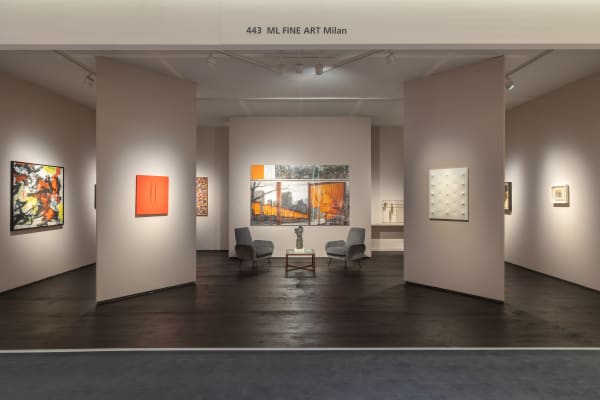
TEFAF Maastricht 2024
7 - 14 Mar 2024We are looking forward to seeing you at TEFAF Maastricht 2024! On this occasion our booth will showcase a selection of historically relevant paintings, sculptures...Read more -

MIART 2021
17 - 19 Sep 2021ML Fine Art is pleased to announce its participation to the 25th edition of Miart, Milan’s international modern and contemporary art fair, that will take...Read more -
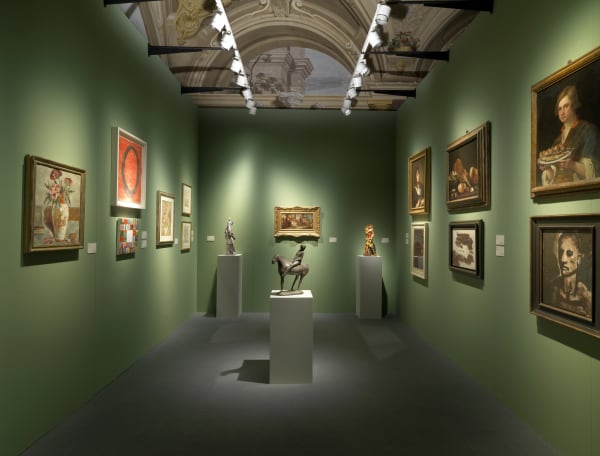
BIAF 2019
Florence International Biennial Antiques Fair 21 - 29 Sep 2019Read more
-
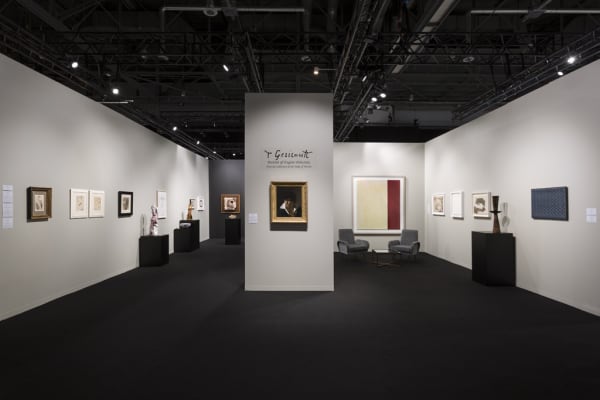
Artgenève 2019
31 Jan - 3 Feb 2019Led by important and historic works by Théodore Géricault, Paul Gauguin, Lucian Freud and Piero Manzoni, M&L Fine Art's booth presented a tightly curated booth...Read more -
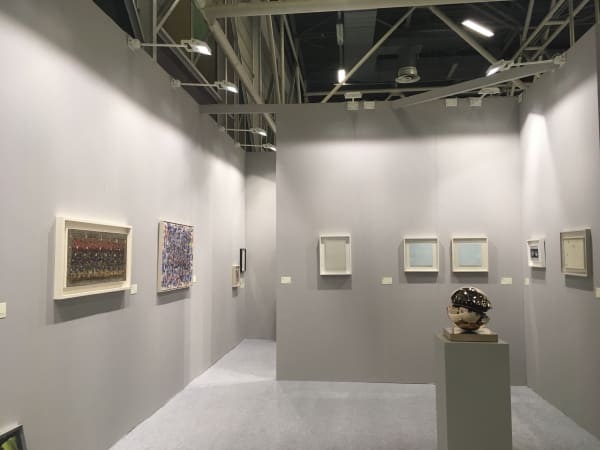
Artefiera 2018
2 - 5 Feb 2018Galleria Matteo Lampertico is pleased to partecipate at Artefiera 2018. Our booth will present a selection of works by Italian artists, including Alberto Burri, Carla...Read more -
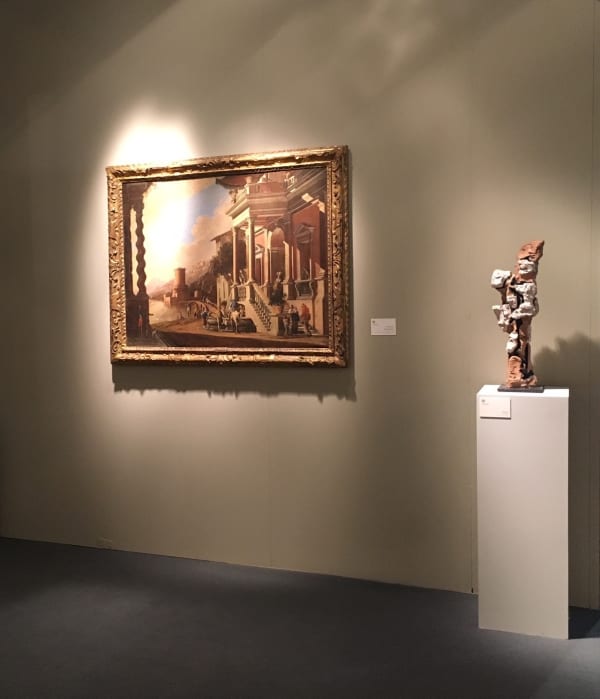
BIAF 2017
22 Sep - 1 Oct 2017Read more -

Miart 2017
31 Mar - 2 Apr 2017Read more
-
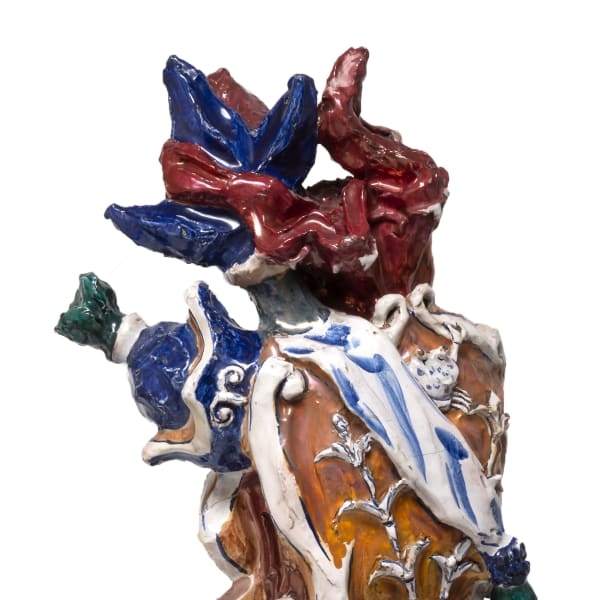
RITORNO AL BAROCCO: Leoncillo Leonardi, Trofei, 1941
February 16, 2021In occasion of the exhibition RITORNO AL BAROCCO. FONTANA, LEONCILLO, MELOTTI, curated by Andrea Bacchi, ML Fine Art is pleased to present an exceptional pair...Read more -

RITORNO AL BAROCCO: Leoncillo Leonardi in conversation with Lucio Fontana
December 11, 2020In occasion of the exhibition RITORNO AL BAROCCO. FONTANA, LEONCILLO, MELOTTI, curated by Andrea Bacchi, ML Fine Art is pleased to present two extraordinary works:...Read more



